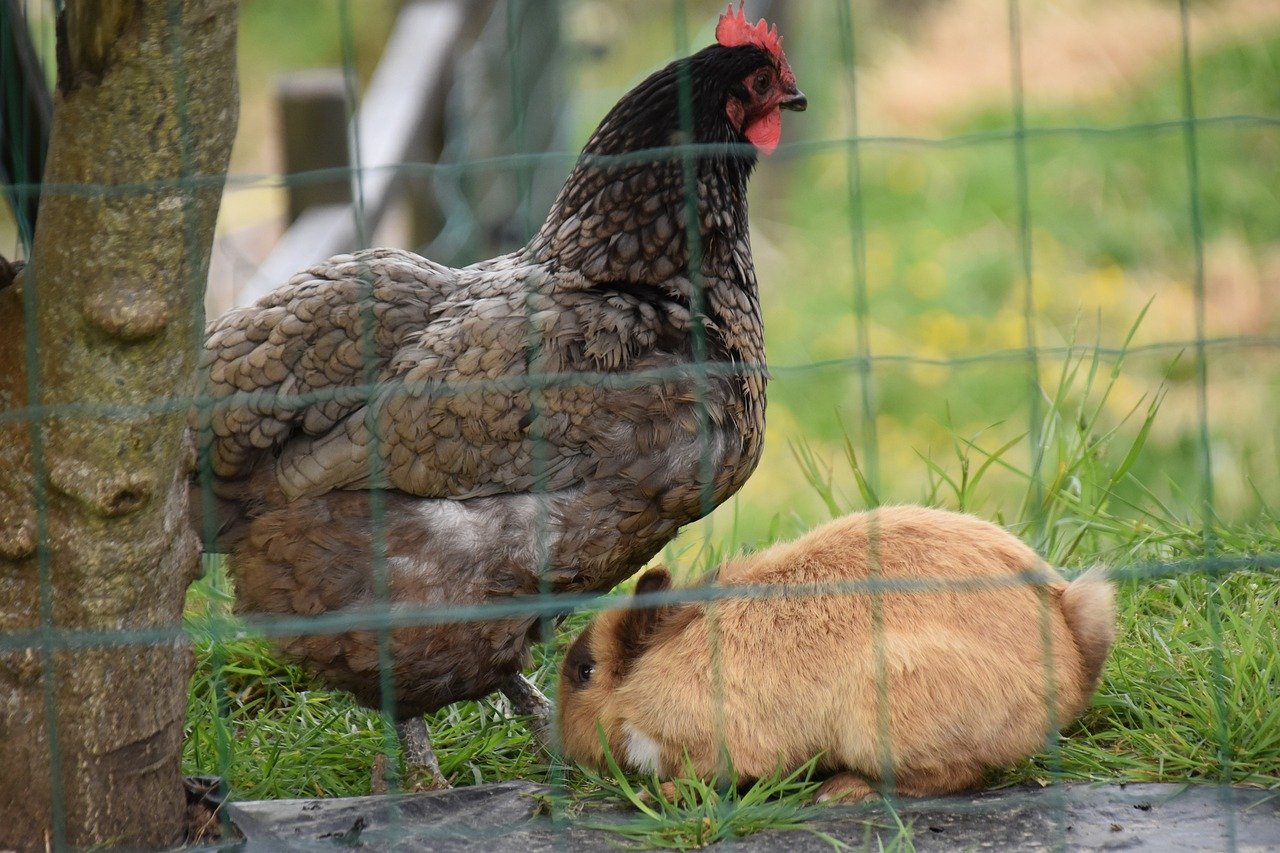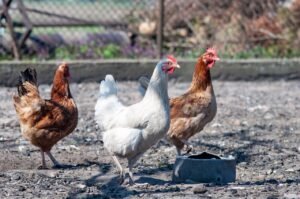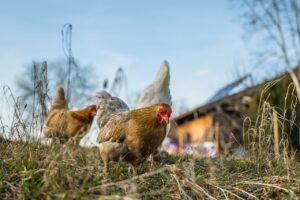
Have you ever asked, can you keep rabbits and chickens together, or with goats? Well, it turns out that this is a common question among those who are considering raising backyard animals. In this article, we will explore the possibility of chickens living harmoniously with their furry counterparts, and delve into the benefits and challenges that may arise from such a dynamic.
So, if you’ve ever wondered about the potential friendships between different creatures, stick around to discover whether chickens, goats, and rabbits can make for the perfect backyard companions.
Can You Keep Goats and Chickens Together?

Benefits of Keeping Chickens and Goats Together
Keeping chickens and goats together can have various benefits for both species. Chickens are excellent at foraging, which means they can help to clear out weeds and keep the grass trimmed. In return, goats provide companionship and security for the chickens. Additionally, their different grazing habits can help optimize the use of pastureland, as chickens tend to focus on insects and smaller plants while goats prefer larger vegetation.
Considerations for Cohabitation
While there are benefits to cohabitation, it is important to consider certain factors before introducing chickens and goats to the same living space. Make sure to assess the size and layout of your land to ensure that there is enough space for both species to roam freely. It is also crucial to evaluate the temperament of your goats and the breed of your chickens, as some may have different levels of compatibility.
Providing Sufficient Space for Chickens and Goats
To ensure the well-being of both chickens and goats, it is crucial to provide sufficient space for each species. Chickens generally require at least 2 to 4 square feet per bird inside the coop and around 8 to 10 square feet per bird in the outdoor run. For goats, it is recommended to have a minimum of 200 to 300 square feet per adult animal. By providing enough space, you can minimize the risk of overcrowding and potential conflicts between the two species.
Separating Feed and Water Sources
To maintain harmony between chickens and goats, it is essential to separate their feed and water sources. Chickens have specific dietary requirements and can consume a variety of feeds, including grains and pellets. In contrast, goats have unique nutritional needs and eat primarily forage, such as hay and fresh vegetation. By keeping their food sources separate, you can ensure that each species receives the appropriate nutrition without competition or potential health issues.
Monitoring Health and Safety of Both Chickens and Goats
Regularly monitoring the health and safety of both chickens and goats is vital for preventing illnesses and injuries. Ensure that their living environment is clean and free from hazards, such as sharp objects or toxic plants. It is also essential to maintain proper hygiene by regularly cleaning their living spaces and providing fresh bedding. Additionally, a regular inspection of their overall well-being, such as checking for signs of illness or injury, should be part of your routine.
Introducing Chickens and Goats
Introducing chickens and goats requires a gradual process to minimize stress and potential conflicts. Start by keeping them in separate enclosures but within sight of each other, allowing them to become accustomed to one another’s presence. After a few days, you can start introducing them in controlled environments, such as supervised free-ranging with close observation. This gradual approach will allow both species to adjust and build familiarity, increasing the chances of a harmonious coexistence.
Managing Waste and Grazing
Both chickens and goats have different waste and grazing habits that need to be managed effectively. Chickens produce manure rich in nitrogen, which can be beneficial as a natural fertilizer for the soil. However, it is crucial to regularly clean their coop to prevent the buildup of ammonia and maintain good hygiene. Goats, on the other hand, have a more extensive grazing range, and rotational grazing can help manage their impact on the land by providing ample time for vegetation to regrow.
Avoiding Predators
Predators can pose a significant threat to both chickens and goats, so it is important to take appropriate measures to protect them. Ensure that their housing is secure with sturdy fencing and reinforced coop enclosures to prevent access by predators. Consider using electric fencing if you live in an area with a high predator population. Additionally, providing shelters and elevated roosting areas can help chickens feel safer and minimize the risk of predator attacks.
Addressing Potential Conflicts
Cohabitation between chickens and goats may sometimes lead to conflicts, particularly during feeding time or if one species becomes territorial. To address potential conflicts, consider providing multiple feeding stations to reduce competition and allow each animal their own space. It may also be helpful to create separate areas within their shared space to ensure each species has a designated area to retreat if needed. By understanding their natural behaviors and needs, you can proactively prevent and manage potential conflicts.
Common Challenges and Solutions
Despite the numerous benefits of keeping chickens and goats together, challenges may arise. Some common challenges include territoriality between goats, aggressive behavior from chickens, or the potential for goats to consume chicken feed. To overcome these challenges, you can consider implementing strategies such as providing separate feeding areas for chickens, installing barriers to prevent goats from entering the chicken coop, or introducing more docile chicken breeds that are less likely to display aggressive behaviors.
Can You Keep Rabbits and Chickens Together?

Advantages of Keeping Rabbits and Chickens Together
Keeping chickens and rabbits together can be a mutually beneficial arrangement. Chickens can provide a form of natural pest control, as they enjoy foraging insects, while rabbits contribute to the fertility of the soil with their manure. The presence of chickens can also help deter predators that may pose a threat to rabbits, creating a sense of security for both species.
Points to Consider Before Coexisting
Before introducing chickens and rabbits to the same living environment, it is important to consider a few points. Assess the size of your available space, as both chickens and rabbits require adequate room to move and thrive. Additionally, take into account the behavior and temperament of your specific chickens and rabbits, as some individuals may be more compatible than others.
Creating a Suitable Living Environment for Rabbits and Chickens
Creating a suitable living environment is vital for the well-being of both chickens and rabbits. Provide separate and secure enclosures to ensure the safety of each species. Both chickens and rabbits should have access to hideaways to retreat to when they feel threatened or need privacy. Additionally, make sure to keep their living spaces clean and free from hazards such as sharp objects or toxic plants.
Ensuring Safety for Both Species
The safety of both chickens and rabbits should be a top priority. This begins with constructing appropriate housing that keeps each species protected from predators. Reinforced wire or mesh fencing can help prevent access by larger predators, while smaller wire mesh can be used to keep rabbits from escaping. Regularly inspect the enclosures for any potential weaknesses and promptly address them to ensure the safety of both species.
Introducing Chickens and Rabbits
After learning the answer to, can chickens live with rabbits, it’s time for an introduction. Introducing chickens and rabbits should be done gradually to minimize stress and potential conflicts. Begin by placing their enclosures near each other, allowing them to become accustomed to each other’s presence. Once they have grown comfortable, you can provide supervised interactions in a controlled environment, such as a shared run. Close observation during these interactions will allow you to address any signs of aggression or territorial behavior.
Dietary Considerations
Chickens and rabbits have specific dietary needs that require attention. Chickens require a balanced diet that consists of grains, vegetables, and proteins. Additionally, they need access to grit for proper digestion. Rabbits, on the other hand, require a diet rich in hay, fresh vegetables, and limited quantities of fruits. It is important to provide separate feeding stations for each species to avoid competition and ensure they receive the necessary nutrients.
Monitoring Health Issues of Rabbits and Chickens
Regularly monitoring the health of both chickens and rabbits is essential for early detection of any potential problems. Keep an eye out for signs of illness or injury and seek veterinary assistance when necessary. Additionally, maintaining proper hygiene within their living environments, such as regular cleaning and providing fresh bedding, will help prevent health issues and promote their overall well-being.
Managing Waste and Bedding
Both chickens and rabbits produce waste that needs to be managed effectively. Chicken manure can be a valuable source of nutrients for plants, but its high nitrogen content requires proper composting before application to avoid burning vegetation. Rabbit droppings, commonly referred to as “bunny gold,” are prized for their low-odor and high nutrient content, making them excellent for plant fertilization. Regularly clean their living spaces and ensure suitable bedding to maintain cleanliness and prevent potential health issues.
Addressing Aggression and Territoriality
Aggression and territoriality can arise between chickens and rabbits, threatening their coexistence. To address these issues, provide separate areas within their shared space where each species can retreat if needed. Additionally, consider providing ample hiding spots or dividers to alleviate potential conflicts and ensure the safety and well-being of both chickens and rabbits.
Coexistence Challenges and Solutions
While coexistence between chickens and rabbits can be beneficial, challenges may arise. Some common challenges include territorial disputes, competition for resources, or potential aggression. To overcome these challenges, it is essential to create a well-designed living environment with separate feeding and resting areas for each species. Additionally, consider the temperament and compatibility of individual animals when choosing to coexist these species together.







